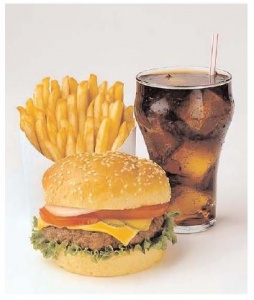Why Is McDonald’s Yellow? The Role Of Environment On Eating Behavior
 |
I’m grateful to the Happy Hospitalist for pointing out that color matters when it comes to food consumption. As it turns out, blue light can be an appetite suppressant. And I actually know about this first hand.
I helped to design a research study in connection with Architectural Digest and the Parsons School of Design several years ago. I was a volunteer instructor for a hospital design course in NYC, and wanted to show the students that lighting could influence eating patterns. As it happened, there was a big gala event at a local convention center, and so I worked with my friend Shashi Caan to set up three identical rooms bathed in three different colored lights (yellow, blue, and red).
We had all the gala attendees dress up in white bunny suits (you know, the kind you let patients wear in the OR) and shuttled them through the 3 rooms at regular intervals. The rooms could each hold about 40 guests and copious identical hors d’oeurves were offered.
Guess what we found? The most food was consumed in the yellow room, followed by red, and then a distant third was blue. About 33% fewer snacks were consumed in the blue room during the event (and yes we controlled the number of people in each room so they’d be equal). I found this quite fascinating, but unfortunately never published the results. You see, I didn’t receive IRB approval for any of it.
But the experiment did leave an indelible impression on my mind. As I thought about it, I realized that most fast food restaurants have yellowish interiors. From the golden arches to the lighting – companies like McDonald’s probably recognized (long before I did) that color influences purchasing and eating behavior.
Yep, I’m late to this party – and I’m not painting my kitchen yellow.

